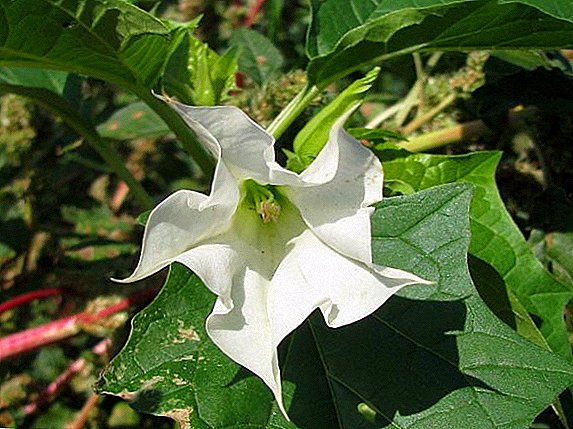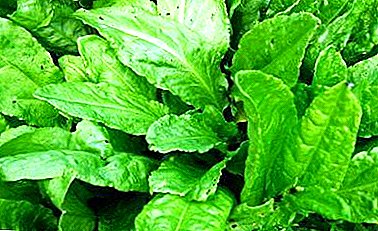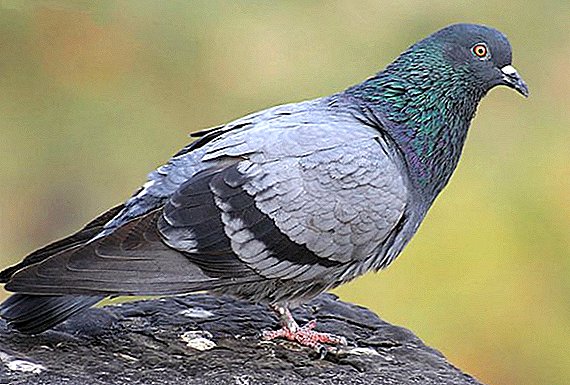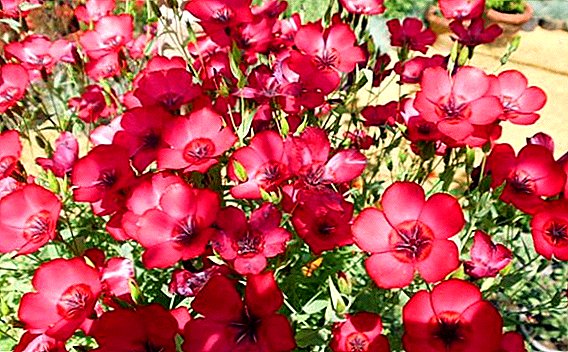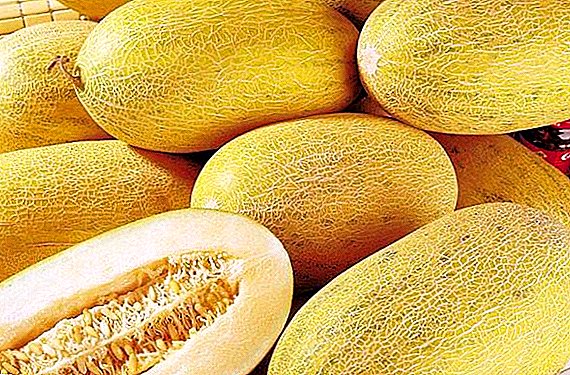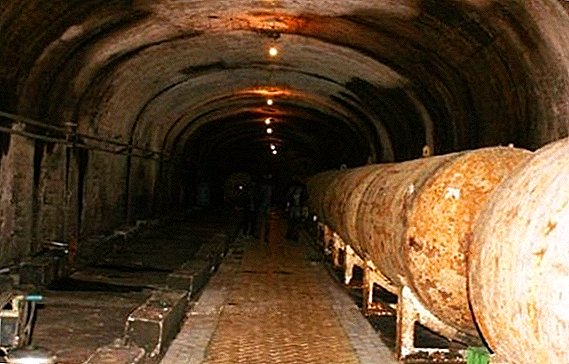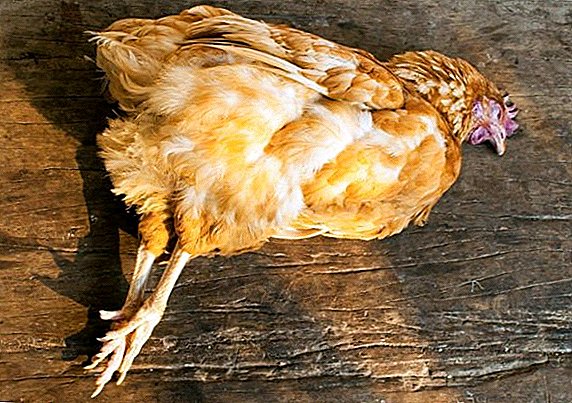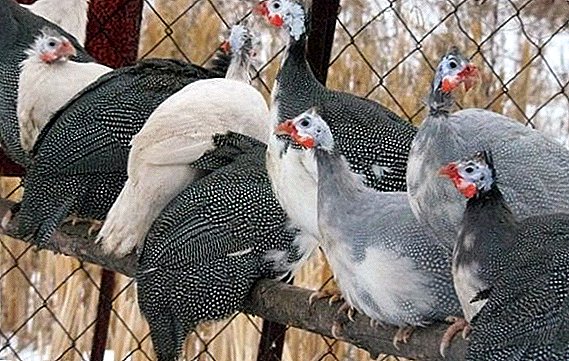 Many farmers engaged in breeding poultry, would like to see a luxurious and noble "royal bird" - guinea fowl settled in their farm. Breeders' interest in these birds is due not only to their high aesthetic data, but also to their excellent productivity. Guinea fowl, despite the fact that they were born in warm countries, tolerate low temperatures normally and quickly get used to their surroundings. How to keep guinea fowls in the winter and how to feed them - let's see.
Many farmers engaged in breeding poultry, would like to see a luxurious and noble "royal bird" - guinea fowl settled in their farm. Breeders' interest in these birds is due not only to their high aesthetic data, but also to their excellent productivity. Guinea fowl, despite the fact that they were born in warm countries, tolerate low temperatures normally and quickly get used to their surroundings. How to keep guinea fowls in the winter and how to feed them - let's see.
Comfortable temperature for keeping guinea fowls in the barn in winter
Guinea fowls have a persistent and enduring character, good health and strong immunity, so even in the winter can freely live in unheated chicken coops, greenhouses. In this case, the only and very important condition is the presence of a perch, without which these birds will simply die.  Despite their simplicity, to increase productivity, it is better to create a warm, comfortable atmosphere for these birds in the hen house. The temperature in the room where royal birds live should not fall to the mark of -10 ° С. However, if guinea fowls are kept together with chickens, then the best indicator will be a temperature of at least +10 ° C.
Despite their simplicity, to increase productivity, it is better to create a warm, comfortable atmosphere for these birds in the hen house. The temperature in the room where royal birds live should not fall to the mark of -10 ° С. However, if guinea fowls are kept together with chickens, then the best indicator will be a temperature of at least +10 ° C.
Read also about the winter maintenance of chickens: feeding for egg production, permissible temperature; arrangement of the chicken coop: lighting, heating (IR lamps), ventilation), diseases of laying hens in the winter.
Preparing the house for winter
Guinea fowl - one of the most freedom-loving birds. They simply will not tolerate crowding, crush, so when arranging a house you need to take into account that for 1 square. m can not be more than 1 individual. For a comfortable existence in the chicken coop in winter, the birds need to create the most comfortable conditions, which consist primarily in maintaining the optimal level of lighting, heating, ventilation and hygiene. 
Additional heating
Guinea fowls tolerate winter and cold well, but do not like drafts, so the main thing is provide them with a spacious room without gaps and holes. Outside the chicken coop, if it is not insulated, you can beat up the boards.
As a rule, insulated capital structures are used on large farms, in agricultural buildings for wintering guinea fowls in order to preserve their egg-laying. Low temperatures down to -50 ° C are tolerated by birds normally, but reduce egg-laying rates. To maintain it at the desired level, you should create a temperature in the room not lower than +10 ° C. If necessary, an additional heat source can be installed in the house, for example, build a small stove, put a heater or an oil heater.
We advise you to read about the winter maintenance of poultry: quails, pigeons, geese, turkeys, turkeys.
Lighting
Birds are not afraid of cold, but the lack of adequate lighting has a bad effect on the health of birds and their egg production, because guinea fowls rush only during daylight hours. The length of daylight hours for an adult should be at least 15 hours.  To do this, several windows are necessarily made in the hen house, and they also take care of installing an additional light source, which should provide lighting in the house from 7:00 to 22:00.
To do this, several windows are necessarily made in the hen house, and they also take care of installing an additional light source, which should provide lighting in the house from 7:00 to 22:00.
Important! With poor lighting, the birds become sluggish, inactive, lose their appetite, refuse to walk, and stop carrying eggs. The use of additional lamps allows to increase the egg production of birds for the year by 30 eggs.
Ventilation
For high-quality development and harmonious growth, the fowl need fresh air, which penetrates into the house due to the organization of good ventilation in the room. The air vent is recommended to be placed in the upper part of the wall in order to avoid direct air flow from the street.
Lack of dampness and drafts
The content of guinea fowls does not tolerate the presence of drafts and dampness in the room. Despite the fact that they have innate strong immunity and resistance to various diseases, it is such wet, wet conditions that can lead to the development of colds, infectious diseases. Even minimal humidity in a chicken coop can negatively affect the health of birds, since a wet environment is an excellent source for the reproduction of bacteria and microorganisms.  Given this, it is recommended to have a poultry house where guinea fowls will live, with a slight bias. In such a sloping room moisture will not accumulate, mold will form, it will always be dry and comfortable.
Given this, it is recommended to have a poultry house where guinea fowls will live, with a slight bias. In such a sloping room moisture will not accumulate, mold will form, it will always be dry and comfortable.
Litter
It is equally important to warm the floor. It is better to cover it with a thick layer of natural materials such as straw, peat, sawdust, etc. During the winter, the litter material is not completely changed, only the top layer is removed, regularly sprinkling new, dry litter to the top as needed. This makes it possible to increase the thermal component and maintain a warm atmosphere in the room.
Did you know? In the post-Soviet countries, guinea fowls were brought from Africa in the 18th century. However, in those days they did not eat the eggs of these birds, much less their meat. They were called "royal birds" because they acted as pets of the nobility. To eat meat and eggs of these birds began only at the beginning of the last century.
What temperature is kept on a winter walk?
Low temperatures during the winter period are not contraindications for walking guinea fowls. On the contrary, they should organize regular walks in the fresh air, but at the same time you need to properly equip a place for walking:
- The first thing to do is to fence the territory, because the birds fly beautifully and are able to fly even through a high fence, and in addition other pets, predators, etc. can enter the territory.
- Also, it is recommended to clear the entire area of snow, snow drifts, dry branches or leaves so that the bird does not hurt.
- In one of the corners of the site you need to build a shed, where birds can hide from the blinding sun, rain or snow.
 At temperatures as low as -30 ° C, birds can be outside all day, but at night they need to be driven into the house so that they can get warm and eat well.
At temperatures as low as -30 ° C, birds can be outside all day, but at night they need to be driven into the house so that they can get warm and eat well.
Did you know? Guinea fowl meat is unique in its characteristics. It contains a huge amount of valuable substances, including 95% of amino acids and water-soluble vitamins. It is also rich in hemoglobin, so it is widely used for the treatment and prevention of anemia.
What to feed guinea fowl
The winter diet of guinea fowls should be complete, well balanced and nutritious. It is recommended to enrich it with various vitamin-mineral complexes and all the missing elements. In the room where the birds live, it is necessary to install additional feeders, filled with shell rock, chalk, gravel, ash and sand. Laying females actively consume calcium, which is used to form eggs and strengthen bones of the skeleton. Therefore, to the traditional feed and dry mixes must add crushed egg shells.  More than 50% of the diet of birds is greens and grass. Of course, in the winter they are not in the proper quantity, so the greens are replaced by various food, meat waste, cleaning vegetables, such as potatoes or carrots. Food is enriched with bone meal, fish oil, dairy products. Birds will not refuse from boiled potatoes, pumpkins, legumes - the main thing is that the food should be fresh, without rot and spoiled ingredients.
More than 50% of the diet of birds is greens and grass. Of course, in the winter they are not in the proper quantity, so the greens are replaced by various food, meat waste, cleaning vegetables, such as potatoes or carrots. Food is enriched with bone meal, fish oil, dairy products. Birds will not refuse from boiled potatoes, pumpkins, legumes - the main thing is that the food should be fresh, without rot and spoiled ingredients.
They feed the birds 3 times a day at intervals of 6 hours. At the same time in the morning and dinner hours give wet mash with the addition of fodder yeast, and in the evening - cereals: millet, barley, millet, bran, corn.
Important! Since the guinea fowl is a regime bird and quickly adapts to the regime, it is recommended to feed it at about the same time. So the birds feel calm, are gaining weight and are rushing well.
The approximate diet of the bird looks like this (in grams):
- cereals (oats - 20, wheat -20, barley - 20, millet - 10, corn - 20);
- fish meal - 15;
- chopped vegetables (carrots or potatoes) - 20;
- clover hay - 15;
- spruce needles - 15;
- yeast - 6;
- fish oil - 3;
- shells, chalk, shell - 5.
 In industrial farms, guinea fowls are fed with special feed, which contains all the necessary micro and macro elements, vitamins.
In industrial farms, guinea fowls are fed with special feed, which contains all the necessary micro and macro elements, vitamins.
Learn more about guinea fowls: breeding at home, incubating and caring for chickens; the benefits of meat and eggs; types and breeds of guinea fowl (common guinea fowl).
Do guinea fowls rush in winter?
Guinea fowl eggs begin to lay at the age of 6 months. With the approach of cold weather, the egg production of birds decreases, therefore, in order to keep it at the proper level, a comfortable temperature of + 15 ... 17 ° C and a 15-hour light day should be maintained in the coop. With such maintenance and maintenance of sanitary and hygienic standards in the room, these birds are able to bring eggs all year round.
Video: guinea fowl in winter
Reviews of poultry farmers about winter maintenance of guinea fowls

As can be seen, the content of guinea fowls in the winter period is quite simple and not troublesome. Birds are absolutely unpretentious in care, they are not afraid of frost, they have strong immunity and almost never get sick. Given all the tricks of the content, it is possible in winter to achieve high rates of productivity of guinea fowls.


